Progress report for LS23-380
Project Information
Passionfruit (Passiflora edulis) is a tropical/subtropical perennial vine with great potential to be grown in subtropical regions such as Florida. It is considered an emerging fruit crop both domestically and internationally. Passionfruit juice is an important source of dietary fiber, ascorbic acid (vitamin C), carotenoids (vitamin A), riboflavin, iron, potassium, and niacin. The fruit pulp can be consumed fresh along with the small seeds. Fruit on the wholesale market are reported to range from about $0.75–$2.00 per piece depending upon market conditions and other variables. The undiluted juice has a strong flavor and is an excellent additive for other juices and drinks. It can also be used in other value-added products including jams, jellies, frosting, ice cream, yogurt, wine, and pastry fillings, thus indicating its great potential for fresh and value-added markets.
In the last few years, passionfruit imported from overseas are being sold at approximately $11/lb at some leading US supermarket chains, indicating the high demand in the domestic market and a farm gate value of $3 per pound easily achievable by farmers. Currently, Florida is estimated to have 150 acres in production, with most acreage located in the state's southern region. Florida could become a significant producer and meet domestic demand with high-quality passionfruit products. However, for passionfruit to become a substantial crop in Florida, there are several key areas where additional research is needed: 1) best management practices (training/pruning, irrigation, nutrition, cultivar performance); 2) pest control; 3) fruit harvest season and maturity, handling practices and fruit quality/shelf life; 4) production costs. Regions of Florida with intermittent freezing temperatures pose a significant threat to passionfruit production, and methods for adequate cold protection, such as high tunnel production, are needed. Productive cultivars with a wide range of desirable characteristics need to be determined. Accurate information concerning these areas will further help producers, processors, and retail establishments to maximize and retain the value of the crop. Marketing aspects of passionfruit is an area that needs substantial investigation to attract potential producers to plant this crop.
An optimized cropping system is needed to maximize profitability and sustainability to support growers. We propose a three-year, multi-institutional, transdisciplinary, regional project with the University of Florida as the lead, collaborating with Florida A&M University, the University of the Virgin Islands, the University of Georgia, and Louisiana State University. Our systematic approach includes applied research and extension activities that will engage growers, industry stakeholders, and consumers to evaluate different cultivars and production systems and reduce barriers for producing and extending passionfruit production in the southern regions. Relevant information developed from this project will be made available to interested growers, with the goal of passionfruit becoming a profitable specialty crop in the south, central, and north-central Florida growing areas, and also other potential regions in the southern regions to permit an extended production window and develop a reliable and consistent supply chain.
- Determine differences among germplasm lines and cultivars for disease and insect resistance, and fruit harvest maturity, yield and quality grown under both production systems.
- Understand the cultural practices required of purple-skinned passionfruit cultivars (edulis type) grown in southern Florida and the Virgin Islands under open fields, and in central and north-central Florida under both open field and high tunnel environmental conditions.
- Increase consistency of supply through improved harvest and postharvest management strategies to extend fruit shelf life and help growers handle their fruit better while improving their returns.
- Develop production management guidelines for best practices for growers.
- Educate growers on how to produce premium fruit with optimum yields for high value for both fresh and value-added markets.
Cooperators
- - Producer
- (Researcher)
- (Researcher)
- (Educator)
- (Researcher)
- (Researcher)
- - Producer
- - Producer
- - Producer
- (Educator and Researcher)
- (Educator)
Research
The research activities are divided into the following different experiments, each involving different materials and methods.
Comparison of growing passionfruit under high tunnel and open field in Central FL: The passionfruit has been grown under a high tunnel and open field research plot in the University of Florida/IFAS Plant Science Research and Education Unit (PSREU), in Citra, FL. The high tunnel has a dimension of 16 × 200 ft having two rows of passionfruit in it. Each row has been trellised on a single wire system with a planting distance of 10 ft with 8 ft between rows (Figure 1). The high tunnel has been established in a North-South direction. Healthy young plants of passionfruit cultivar ‘Possum purple’ were transplanted inside the tunnel in the month of June 2023. To compare the plant health and fruit quality, similar plants were also planted outside the tunnel in an open field with a planting distance of 10 × 10 ft. All the cultural practices, plant nutrition, and irrigation are being kept constant for both tunnel and open fields. There is a mist system installed in the high tunnel that can give additional protection against freezing. Both systems are currently being evaluated for the differences of microclimate and its impact on plant growth, health, and fruit quality. The major observations involved data on microclimate (temperature and relative humidity), plant mortality rate, freeze or frost damage, differences in phenological stages, fruit Yield, fruit quality, and harvest window. d

As cultivars of certain plants perform differently under different climatic conditions with variations in fruit quality, different cultivars of passionfruit are being evaluated for survival and performance under the different climatic conditions of Florida. At the initial stage, three different cultivars, including ‘Possum purple’, ‘Panama red’, and ‘Bounty’, were planted in an open field at PSREU. Young healthy plants of these cultivars were transplanted during June.
A preliminary study was carried out where the vine trunks of passionfruit were covered with different materials to protect them from freeze injury. These materials include covering the stem with wheat straw, Styrofoam, and plastic sheet (tree guard) used against herbicide protection. Trunks were covered during the last week of December, before the freezing prediction. Dataloggers were installed in each covering material to record the efficacy against low temperatures. In control, no covering was applied around the vine trunk, and a data logger was installed with the trunk within the height of 1 ft. Besides recording microclimate data through dataloggers, plants were observed for plant mortality, plant health, and any freeze injury symptoms on leaves.
Cultivar comparison in South FL: A 0.58-acre passionfruit planting was established 19 July 2023 at the UF/IFAS-Tropical Research and Education Center, Homestead, FL (Figure 2). The site has a marine subtropical climate with a crushed oolitic limestone, sand, silt, clay and ~2% organic matter content soil. Three purple-type passionfruit cultivars were planted, ‘Possum Purple’, ‘Panama Red’ and ‘Bounty’ at a 10-foot in-row by 15- foot between-row spacing. Ground cloth was placed in-row to suppress weeds, and a microsprinkler irrigation system was established. There were nine to twenty individual plants per cultivar. There were some vines lost due to extreme July-August temperatures in 2023.
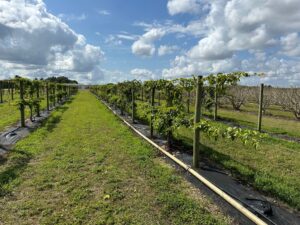
Two-months post plant establishment trunk diameters were measured (Sept. 5, 2023) and subsequently two-to-three times per month plant phenology (i.e., presence of new growth, flower-buds, flowering, fruit set, fruit for harvest) was recorded (14 times to date). The frequent phenology assessment is necessary due to the rapid growth of the vines and the desire to capture differences in cultivar performance under South Florida conditions. A small amount of fruit was harvested and fruit quality (e.g., weight, diameter, °Brix) determined. Our plans are to continue the data collection.
Approximately 125 selected passionfruit seedlings are scheduled to be planted mid-April 2024. These will be evaluated for potential use as a superior selection or cultivar in the future.
Cultivar comparison (South Florida): A 0.58-acre passionfruit planting was established 19 July 2023 at the Tropical Research and Education Center, Homestead, FL. The site has a marine subtropical climate with a crushed oolitic limestone, sand, silt, clay and ~2% organic matter content soil. Three purple-type passionfruit cultivars were planted, ‘Possum Purple’, ‘Panama Red’ and ‘Bounty’ at a 10-foot in-row by 15- foot between-row spacing. Ground cloth was placed in-row to suppress weeds and a microsprinkler irrigation system established. There were nine to twenty individual plants per cultivar. There were some vines lost due to extreme July-August temperatures in 2023. Some vines were replanted during September.
Cultivar and/or seedling collection. Approximately 125 selected passionfruit seedlings were planted May 3, 2024. Currently, they are flowering and fruiting, and fruit counts and quality data are in progress.
Establishing a demonstration passionfruit plot at the University of the Virgin Islands: in February 2024 144 tissue-culture plants of ‘Possum Purple’ were received. From the trays, they were transplanted into pots and are currently growing in the greenhouse until they are large enough to be distributed to farmers for planting in the field (Figure 3).
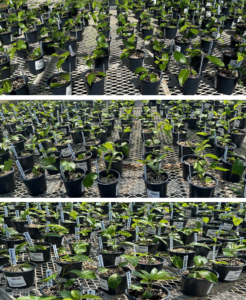
Trellises were installed at different farm sites, using the same design. Materials used to construct the trellis were 3in. x 4in. x 8 ft. round edge post, ½ in. x 6 ft. natural bamboo poles, seven gauge galvanize tension wire, U nails, concrete mix, 3/8 in. x 10-1/2 in. turnbuckle with eye/hook, 1/8 in. wire rope clip, portable auger, come-along tool and large eyebolts. The first trellis was installed at UVI SOA AES as a prototype, two-foot-deep holes were dug, and five 3 in. x 4 in. x 8 ft. round edge post were put in at 24 ft. spacing. Concrete mix was then poured into a hole dug at five feet before the first post and another hole dug at five feet after the last post, with a large eye bolt resting in the center of the concrete. This acted as the anchor for the galvanized tension wire. After the concrete had set, a come-along tool was used to tighten the galvanized wire to the top of the wooden posts, once tightened U nails were used to secure and center the tension wire at the top of each post. A 6 ft. wide weed barrier fabric was placed within the row to control weeds, and microirrigation was installed. Twenty-five-gallon pots were used for planting. They contained a mixture of 15 gallons Promix, 4gallons local topsoil, 4gallons Milorganite 6-4-0 fertilizer and 3gallons fine grain vermiculite. One ‘Purple Possum’ passionfruit plant was transplanted into each of the eight 25-gal pots at an in-row spacing of 10 ft. (Figure 1). This method was replicated at each farm site but instead of pots they were transplanted directly into the soil, each farmer was responsible for installing their own irrigation. All plants and trellises were put in between the months of July 2024 – December 2024.
Postharvest studies: Passionfruit was harvested three times during fall 2023: Sept 12 (Test 1, variety unknown), November 2 (Test 2, ‘Ruby Red’) and December 11 (Test 3, ‘Ruby Red’) from commercial farms in Homestead, FL. Fruit was collected at two harvest stages, either from the ground or clipped from the vine, and transported to the UF Postharvest lab the same day. For each test, the fruit was held overnight at 10 °C and the following day sorted and organized for storage. Test 2 fruit arrived with decay symptoms, so the samples were grouped according to decay severity (Figure 4). Fruit with severe symptoms were evaluated after 7 d, those with moderate symptoms after 14 d and those with mild symptoms after 21 d. Fruit (n=60) from both harvest stages were stored at 10 °C and 90% relative humidity. Each week, half of the fruit from each harvest stage (Test; 1 n=7, Test 2: n=5 and Test 3: n=7) were evaluated for quality while the remaining fruit were transferred to 20 °C and evaluated when the fruit became shriveled (> 25% surface area). For Tests 1 and 3, the 21-d samples were tracked for weight loss and color during storage. However, for Test 2 the weekly samples were measured independently since each week was initially grouped according to decay severity.
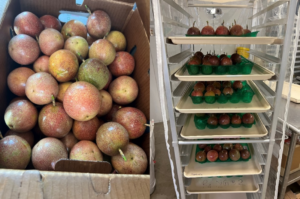
Open field and high tunnel studies
High tunnels can modify the microclimate inside the tunnel, and it can trigger early crop production and extended harvest in addition to freeze protection. During observation of the first growing season, growing passionfruit under the high tunnel resulted in good plant health without any symptoms of freeze or frost damage as compared to open fields. Out of the total, 80% of plants in high tunnels resulted in excellent plant health, based on visual scoring, while in an open field, only 25% of plants ranked in the same category. The high tunnel also helped protect the plants from freeze injury by keeping the temperature above 32 °F, whereas the temperature went below freezing in the open fields and caused leaf injury in plants (Figure 5). The tunnel was kept open until there was a freeze prediction by the weather forecast.

Besides protecting the plants from freeze injury, the high tunnel also resulted in advancing the growth stages and fruit development. We recorded a good production during the starting from February and month of March, where there was no fruit in open field. About 815.6 g of fruit per plant was harvested till the last week of March. An early flowering has also been recorded under the high tunnel that can benefit the grower by early production and extending the harvest window (Figure 6).
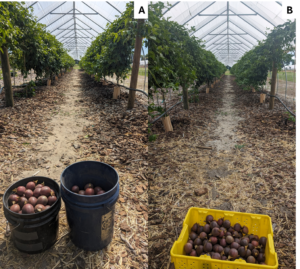
Severe weather conditions were observed during the late fall and winter season of 2024-25, with a minimum temperature of 22.9ºF in the open field. The high tunnel with a mist system helped maintain a higher temperature, with a minimum temperature of 32.4ºF in the high tunnel during the season. Due to the freeze events in the open field, all plants suffered a complete loss of foliar parts, whereas no damage was observed in the high tunnel (Figure 7). Although the trunks from a few inches above the ground were looking green and the dead part had been cut, to observe resprouting, 15.2% of plants were able to resprout.
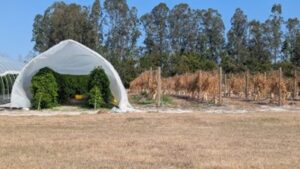
During field observations, leaf samples at various growth stages and locations were collected to be tested for pests and diseases. The Samples were submitted to the UF Plant Diagnostic Center for further assessment. Attack of thrips and mites was recorded especially from the open field trial in Citra, while geminivirus was detected at a farmer’s field in central Florida, where the plant material was discarded (Figure 8).
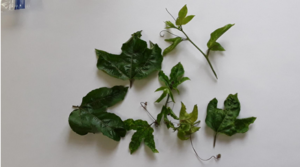
During initial observations, a freeze event was recorded on January 21st in PSREU, Citra which was also depicted in the data recorded by the dataloggers installed in passionfruit field trials. Among different materials, used for trunk covering and protection against freezing, wheat straw resulted in maintaining the temperature above freeze (34.7 ºF) as compared to other treatments that ranged from 27.7 – 29.8 ºF (Figure 9).
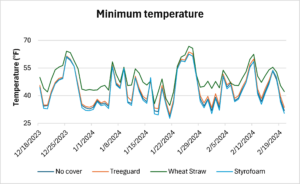
Comparison of training system (single vs double cordon)
Comparing the training system for plant growth and fruit quality, passionfruit plants in the open field were established as both single and double cordons over a 6-foot-high wire above the ground (Figure
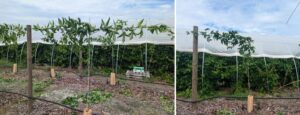
10). The plants were maintained as single trunks, with any laterals on the main trunk removed. Plant health and fruit-bearing were good in both training systems; however, winter freezes in the open field resulted in a loss of plant material, precluding a comparison of fruit production, yield, and quality from the experiment. The experiment will be repeated in the high tunnel in 2025.
Impact of fruit size on fruit quality
Mature fruit of ‘Purple Possum’ passionfruit fruit grown under a high tunnel at PSREU, Citra was collected from the ground and to observe the relationship between the fruit size and quality by categorizing the fruit into four weight groups: less than 40g, 40-50 g, 50-60 g and above 60 g (Figure 11)
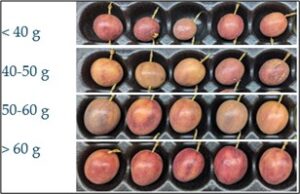
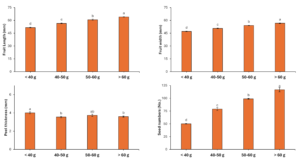
Results revealed notable variations in different parameters, highlighting a significant correlation between fruit size and physico-chemical attributes, including seed numbers, flesh weight, juice contents, fruit firmness, TSS, maturity index, and peel thickness. Analysis of bioactive compounds and confirmatory experiments is in progress, and the results will be shared after the data collection is complete (Figure 12).
Identification of diseases and pests on passionfruit grown in Florida during the growing season
Anthracnose; Colletotrichum Leaf Spot (Colletotrichum sp./spp.)
Southern Blight (Athelia rolfsii) (syn. Sclerotium)
Geminivirus (Geminivirus Group)
Potyvirus Group (Potyviridae)
Fusarium wilt of vegetables (Fusarium oxysporum)
Rhizoctonia Crown Rot (Rhizoctonia sp.)
Pythium root rot ORN (Pythium sp./spp.)
Anthracnose Fruit Rot (Colletotrichum sp.)
Cultivar compression South Florida
Vine growth: All 19 of the ‘Possum Purple’ vines survived from July 19, 2023, until June 26, 2024, when one vine succumbed to trunk and root rot. Subsequently, three more vines were dead by October 28, 2024. All 19 ‘Panama Red’ vines survived until one was dead by August 8, 2024. In sharp contrast, 15 of the 20 ‘Bounty’ vines planted died by six months after planting. Most mortality took place within the first two months of planting due to excessively high temperatures (>95°F) experienced in Homestead. Vines were replanted April of 2024. New vine growth was present on all three cultivars from ~1.5 months post planting throughout September 2023 to December 2024 period. The presence of flower buds present varied among the cultivars as did their intensity (i.e., relative prevalence). Similarly, the fruit set period and developmental periods varied in length and intensity. The harvest periods were similar among the cultivars, but we did not capture the entire harvest periods. During the 2023-2024 season fruit were harvested from vines of all three cultivars. Production was low for all three cultivars during November, December, and April but much higher during May (Figure 9)
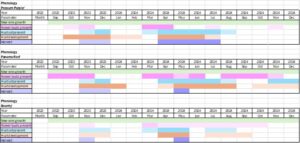
Fruit quality: Fruit size and weight varied for all three cultivars throughout their harvest periods with relatively large fruit but lighter weights (e.g., ‘Possum Purple’ harvested from February through May) indicating poor pollination thus low seed and aril weights. Over the harvest period the sweetness of the cultivars varied from a low of 13 °Brix to 17.1. °Brix for ‘Panama Red’ and ‘Bounty’ increased from winter to summer. In contrast °Brix for ‘Possum Purple’ decreased during spring and then rebounded during summer.
Establishing a demonstration passionfruit plot at the University of the Virgin Islands
During 2024 we received an unusually large amount of rainfall, which with the poor drainage of the clay soils contributed to the five farmers located in the community gardens on St. Croix having difficulties growing their passionfruit due to root rot. Another famer in the community gardens saw an infestation of armored scales and requested to withdraw from the project (Figure 10). Two farmers located in Sion Hill and Glynn on St. Croix are experiencing issues with deer eating their plants (Figure 11). The farmer on St. Croix with the highest survival rate is located on the western end of the island, however those plants are showing signs of disease (Figure 4). The four other farmers, three on St. Croix and one on St. Thomas have yet to transplant their plants. One farmer reported that he delayed planting due to the heavy rain and another due to lack of available time.
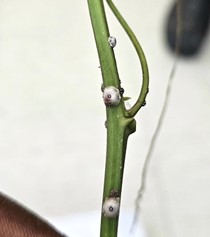
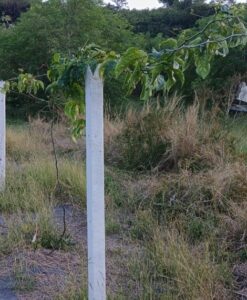
Postharvest studies
Test 1: Passionfruit weight loss during storage was similar between fruit harvested from the ground and the vine. Values ranged from 2% after 7 d to 6-7% after 21 d at 10 °C and 7-8% after 26 d (21 d at 10 °C + 5 d at 20.
The external *hue angle for fruit harvested from the ground remained around 45° throughout storage. Fruit harvested from the vine had slightly higher peel color at harvest (57°) that decreased to 33° after 26 d. However, due to variability between the reps, there was no difference between the harvest stages.
During storage at 10 °C for 21 d fruit harvested from the vine had less shriveling (4-34 percent area) compared to fruit harvested from the ground (9-71 percent area). This trend also held true after transfer to 20 °C however values were much higher for both ground (58-86) and vine (3-64%). There was no decay development during storage (Figure 12).
The pulp yield was similar for ground and vine fruit throughout storage at 10 °C (57%), however after transfer to 20 °C ground fruit had slightly less pulp (54%) compared to vine fruit (58%) although it was not significant.
During storage at 10 °C, SSC values averaged 17 °Brix for passionfruit harvested from the ground and vine, while TTA values were lower for fruit harvested from the ground (3.8 % citric acid) compared to the vine (4.6 % citric acid). After transfer to 20 °C the trend was the same, however SSC and TTA values were lower (ground SSC=15.4; TTA=3.4) and (vine SSC=16.4; TTA=4.1). The pH values averaged 3.3 throughout storage regardless of harvest stage. SSC/TTA ratio averaged 4.5 for ground and 4.0 for vine harvested fruit after 21 days storage at 10 °C and transfer to 20 °C.
Although most parameters were similar between the two harvest stages, fruit harvested from the ground consistently had better aroma than fruit harvested from the vine regardless of storage time.
Ethylene production was higher at harvest and during 1 week of storage (20 °C) for ground (231 µL/kg/h) harvested fruit compared to the vine (93 µL/kg/h). Ethylene measurements on day 8 and 11 averaged about 170 (µL/kg/h) regardless of harvest stage. Respiration rate averaged 48 mg/kg/h for both harvest stages up to 6 d. For days 8 and 11 respiration averaged 73 mg/kg/h for ground and 42 mg/kg/h for vine harvested fruit however it was not significant due to sample variability.
Images at harvest and after 21 d at 10 °C show an increase in shriveling especially for ground harvested fruit. On day 26 after transfer to 20 °C for 5 d both ground and vine harvested fruit had more shriveling compared to before transfer (Figure 13).
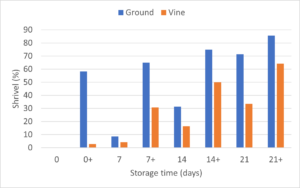
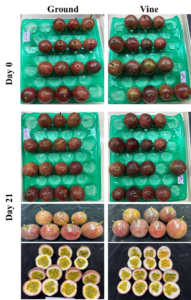
Test 2: ‘Ruby Red’ (RR) passionfruit harvested from the ground and the vine had similar weight loss during storage. Values ranged from 1.5% after 7 d to 5.5% after 21 d at 10 °C.
The external hue* angle for fruit harvested from both the ground and the vine averaged 34° during storage. Even though the ground harvest fruit was initially higher (44°) due to variability between the reps, there was no difference between the harvest stages.
Minor shriveling (< 20%) developed during storage at 10 °C; however,
fruit transferred to 20 °C had higher incidence (20-75%) (Figure 14).
The pulp yield was similar for ground and vine fruit throughout storage at 10 °C and transfer to 20 °C.
During storage at 10 °C, passionfruit internal quality was similar between fruit harvested from the ground and vine. The average values during storage were 17 °Brix and 4.5 % citric acid. After transfer to 20 °C the SSC remained similar while TTA decreased compared to fruit stored at 10 °C. The SSC/TTA ratio was also similar between harvest stages throughout storage, averaging 3.8. The pH values averaged 3.2 throughout storage regardless of harvest stage.
At harvest, the fruit showed decay symptoms, however the symptoms did not worsen and there was no additional decay development during storage (Figure 15).

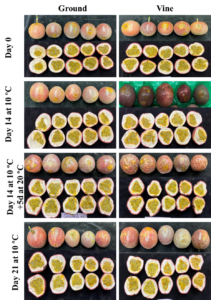
Test 3: For ‘Ruby Red’ (RR) passionfruit, weight loss was similar regardless of ground or vine harvest. Values ranged from 2% after 7 d to 6.5% after 21 d at 10 °C.
At harvest, fruit collected from the ground had more color development (*hue=28°, red/purple) compared to fruit harvested from the vine (*hue=45°, light red). There was less color change during storage for fruit harvested from the ground.
During storage at 10 °C there was minimal shriveling symptoms except for ground harvested fruit after 21 days (40%). Fruit transferred to 20 °C had higher incidence (35-100%) (Figure 16).
There were no significant differences in pulp yield between ground and vine harvested fruit during storage. However, fruit harvested from the vine tended to have lower pulp yield during storage at 10 °C, but after transfer to 20 °C, this trend was not observed.
During storage at 10 °C, the SSC was similar between fruit harvested from the ground and vine (14 °Brix). Although not significant, the TTA was lower for ground harvest fruit (3.8%) compared to vine harvested (5.0%) which impacted the SSC/TTA ratio averaging 4.1 for ground and 3.0 for vine. The pH values averaged 3.1 throughout storage regardless of harvest stage. Transferring fruit to 20 °C did not affect the fruit quality parameters tested.
There was no decay incidence during storage for this test. Visual symptoms of shriveling did not appear until 21 d at 10 °C and increased after transfer to 20 °C (Figure 17).
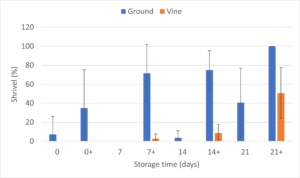

Passionfruit (‘Possum Purple’) was harvested June 17, 2024, from the open field plots at UF/IFAS PSREU in Citra, Fl. Fruit was harvested either from the ground or clipped from the vine then transported to the UF Postharvest lab where they were sorted and organized for storage. Fruit (n=56) from both harvest stages were stored at 10 °C and 90% relative humidity. Each week, half of the fruit from each harvest stage (n=7) were evaluated for quality while the remaining fruit were transferred to 20 °C for an additional 7 days.
An additional test was conducted at room temperature (22 °C) using vented plastic containers. Fruit (n=7) from each harvest type (ground and vine) was placed in a container with or without a vented lid.
The quality parameters measured were as follows.
- External color
- Weight loss
- Visual rating (shrivel as % area, decay as % fruit affected)
- Pulp yield (% of total fruit weight)
- Soluble solids content (SSC), Total titratable acidity (TTA), pH
Changes during storage and ripening were as follows:
- Fruit clipped from the vine had higher weight loss (7%) compared with fruit collected from the ground (5%) during storage at 10 °C for 21 days. After 21 d fruit was transferred to 20 °C for an additional week in which weight loss doubled to 10 and 14% for fruit harvested from the ground and vine, respectively.
- At harvest, hue* angle was higher for vine harvested (74°) compared to ground harvested (34°) fruit, indicating a lighter color of vine harvested. Hue* angle decreased for both harvest stages during storage at 10 °C, however after 21 d it remained significantly higher for vine harvested fruit. After transfer to 20 °C the hue* angle for vine harvested fruit decreased 25% but was still 50% higher (less orange) than ground harvested fruit.
- The rating for shrivel had high variability between the reps for both harvest types. Fruit collected from the ground exhibited more shrivel symptoms during the first week of storage at 10 °C; however, during the second and third week of storage the vine harvested fruit had higher percent shrivel. There was also more fruit with shriveling after transfer to 20 °C.
- Pulp content averaged 50% for both harvest stages throughout the storage period. SSC decreased slightly from 19° at harvest to 16° after 21 d for both harvest stages. Acidity was slightly higher for the vine harvested fruit until 14 d then the trend reversed. Similarly, the SSC:TTA ratio was higher for ground harvested fruit until day 14.
Countertop Container Test
- Fruit stored in the container with a closed but vented lid exhibited dramatically less shrivel (30%) compared to fruit stored without the lid (100%). There was no difference between the ground and vine harvested fruit. Interestingly, the pulp content was higher for fruit stored in the open (60%) vs closed (50%) container. Pulp content was calculated by dividing the whole fruit weight by the pulp weight. However, pulp weight was consistently about 25 g while whole weight was lower for fruit stored in the open container; therefore whole fruit had a higher percentage of pulp content.
- The container type/humidity level did not affect the chemical composition.
Education
On June 29th, 2024, a sensory evaluation was conducted at the Downtown Ocala Market. To gauge potential consumer interest in different passion fruit varieties, we evaluated two passion fruit varieties Ruby Yellow and Possum Purple. A total of 121 participants completed the anonymous online survey that was linked with a QR code. Participants were asked if they had previously consumed fresh passion fruit. Participants responded 69% (n=84) “no” they had not, while 31% (n=37) responded “yes” they had. Participants were then asked if they had consumed any kind of passion fruit product. Participants responded 40% (n=48) “no” they had not, while 60% (n=76) responded “yes” they had. A likability rating scale of 1 to 9 was used for the sensory portion of the survey. The evaluation provided participants with fresh cut samples of a purple (P) and yellow (Y) variety. Participants provided the following ratings: overall appearance 7.4 (P) and 7.6 (Y), aroma 7.8 (P) and 7.5 (Y), flavor 7.4 (P) and 6.7 (Y), and overall liking 7.4 (P) and 6.8 (Y). When asked if they preferred one over the other, participant results showed 62% preference for the purple variety over a 38% preference for the yellow variety. This sensory evaluation provides essential marketing information to current and prospective growers about consumer preferences for two different passion fruit varieties.
On August 1st, 2024, we held the Passion fruit field day at the Plant Science Research & Education Unit in Citra, FL. This event began with a tour of or passion fruit research plots. Approximately 130 individuals participated in the tour component of the field day. Returning from the field we began presentations on the following topics:
- Introduction to passion fruit production
- Research update on high tunnel vs. open field production
- Harvest maturity effects on fruit shelf life and pulp quality
- Nutrition & culinary uses of passion fruit
- Sensory evaluation results (from June 29th) and audience sensory evaluation
- Passion fruit pest control
- Student presentations
Approximately 120 individuals were in the audience for the presentations. It is notable that multiple attendees were from out of state and six flew in from Thailand to attend the presentation and tour. After the tour and presentations a program evaluation was sent out to participants. A total of 60 survey responses were return. When asked if participants gained knowledge, 100% (N=60) indicated they gained knowledge from this program. When asked if they intended to implement what they learned, 98% (N=59) indicated they intended to do so. When asked if they gained knowledge about passion fruit nutrition or culinary uses, 100% (N=60) indicated they had gained knowledge. When asked participant’s interest in growing passion fruit, 5% (n=3) were currently growing passion fruit commercially, 38% (n=23) were interested in growing it commercially, and 57% (n=34) were interested in growing it for personal consumption or as a hobby.
Additional support is provided to growers with field visits, phone and email consultations, etc.
Educational & Outreach Activities
Participation summary:
Two programs were held in 2023 that promoted passion fruit at the Plant Science and Education Unit in Citra. Faculty presented on specific topics related to on-going passion fruit research, crop production fundamentals, culinary uses, market & economics, and common pests & diseases. More than sixty-seven people attended these events online and in-person. A tour was also provided to the attendees of the passion fruit research plot we installed earlier in the year. Participants were able to see how we installed the irrigation system, plants, and trellis system. This event also featured a range of passion fruit products for the participants to sample and become familiar with. This allowed the participants to understand the myriad of uses passion fruit has as a value-added product. Everyone was provided with an agenda and on the agenda was a QR code to the EDIS document about passion fruit and a post-program survey. The survey yielded the following: 100% (n=22/22) reported they gained knowledge, 91% (n=20/22) intended to implement what they learned, and 100% (n=22/22) gained knowledge about passion fruit uses. Of the attendees, 50% (11/22) indicated they were interested in growing passion fruit on a commercial scale. This field day served to aggregate essential information about passion fruit production for prospective growers as well as increase visibility for this new alternative crop that can be grown throughout most of Florida.
In addition to formal programs about passion fruit production, a passion fruit sensory evaluation was conducted in 2023. This sensory evaluation was conducted largely to help inform growers about public interest in the crop and demonstrate its economic viability. The information provided by this evaluation could greatly assist growers in making an information-driven decision on whether or not they should plant passion fruit and specifically what buyers were most interested in. This evaluation begins to set a standard for how passion fruit is evaluated. This sensory evaluation was conducted on July 22nd at the Saturday Ocala Downtown Market. A total of 111 participants completed the anonymous survey. The gender demographics of the participants included 79 females, 29 males, 2 preferred not to say, and 2 preferred a different term. The ethnic and racial demographics included 79 non-Hispanic and 21 Hispanic, 78 White, 9 Asian / Pacific Islander, 5 Black / African American, and 1 Native American. Participants were asked if they had previously consumed fresh passion fruit. Participants responded 54% (n=60) “no” they had not, while 46% (n=51) responded “yes” they had. Participants were then asked if they had consumed any kind of passion fruit product. Participants responded 34% (n=38) “no” they had not, while 66% (n=73) “yes” they had. A likability rating scale of 1 to 9 was used for the survey. The likability scale ranged from a rating of 1 (“dislike it extremely”) to a 9 (“like it extremely”), with seven rating choices in between. Participants provided the following ratings for fresh passion fruit: overall appearance of 6.39, aroma of 7.86, overall texture of the fresh fruit pulp and seeds of 7.1, flavor of 7.46, and overall liking of 7.45. The survey concluded with a question about whether or not they would buy fresh passion fruit grown in Florida if it was available. Participants responded with 93% (n=102) “yes” and 7% (n=8) “no”. The results of the study are extremely important to demonstrate to potential commercial growers of passion fruit that a market exists, and the fruit or product characteristics potential buyers are interested. This information could be used to provide an incentive to plant more commercial acreage. Combined with effective sustainable production, passion fruit has the potential to become a significant commercial crop in Florida.